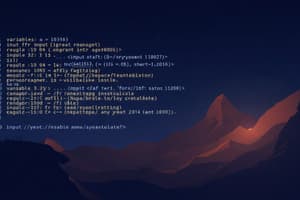Podcast
Questions and Answers
What does the keyword int to the left of main indicate?
What does the keyword int to the left of main indicate?
- main is a function with no parameters.
- main returns a floating-point value.
- main returns an integer value. (correct)
- main does not return any value.
What is the purpose of the left brace { in a C++ function?
What is the purpose of the left brace { in a C++ function?
- To start the body of the function. (correct)
- To signify a loop structure.
- To define a new variable.
- To indicate the end of the function.
Which operator is used to assign values in C++?
Which operator is used to assign values in C++?
- +
- = (correct)
- ++
- ->
Which of the following statements is true about the main function in C++?
Which of the following statements is true about the main function in C++?
What does std::cout represent in a C++ program?
What does std::cout represent in a C++ program?
When performing an addition operation, which of the following is considered an operand?
When performing an addition operation, which of the following is considered an operand?
What is the role of the stream extraction operator in C++?
What is the role of the stream extraction operator in C++?
Which statement accurately describes the use of the = operator?
Which statement accurately describes the use of the = operator?
What is the purpose of comments in a C++ program?
What is the purpose of comments in a C++ program?
What does a preprocessor directive in C++ do?
What does a preprocessor directive in C++ do?
Which line begins the main function in a C++ program?
Which line begins the main function in a C++ program?
What are single-line comments in C++ indicated by?
What are single-line comments in C++ indicated by?
In a typical C++ program, what is the significance of the line '#include '?
In a typical C++ program, what is the significance of the line '#include
What happens to comments when a C++ program is compiled?
What happens to comments when a C++ program is compiled?
Which of the following is true about the 'main' function?
Which of the following is true about the 'main' function?
What is the primary purpose of the line 'return 0;' in a C++ program?
What is the primary purpose of the line 'return 0;' in a C++ program?
Flashcards are hidden until you start studying
Study Notes
First C++ Program: Printing a Line of Text
- The provided program demonstrates basic C++ syntax and features.
- Lines 1-11 constitute the source code, with line numbers excluded.
- Comments are denoted by //, which indicates that the remaining part of the line is a comment.
- Comments assist in documenting programs and enhancing readability for others.
- Comments are ignored by the C++ compiler during execution.
- The comment "Text-printing program" describes the program's purpose.
#include Preprocessor Directive
- The #include directive signals the C++ preprocessor to incorporate the contents of the specified header file.
- Header files provide vital information for compilation.
- The line
#include <iostream>incorporates the input/output stream header file, essential for programs using keyboard input or screen output.
The main Function
- The
mainfunction is crucial for every C++ program. - The parentheses following
mainindicate it's a function, a fundamental building block in C++. - C++ programs typically comprise one or more functions and classes.
- The program execution always begins at the
mainfunction, even if it's not the first function defined. - The keyword
intprecedingmainsignifies that the function returns an integer (whole number) value. - Braces ({ }) enclose the function's body, marking its beginning and end.
An Output Statement
- The statement
std::cout << “Welcome to C++ programming!” << std::endl;is responsible for printing the output. std::coutis the standard output stream, typically directed to the console.- The
<<operator sends information to the output stream. std::endlinserts a newline character, advancing the cursor to the beginning of the next line.
Modifying Our First C++ Program
- The addition of a user input statement allows the program to interact with the user.
- The
std::cinobject allows input from the standard input stream, usually the keyboard. - The
>>operator extracts data from the input stream.
Another C++ Program: Adding Integers
- This program calculates the sum of two integers provided by the user.
- The
intdata type is used to store integers, which represent whole numbers. - In-depth explanation of Arithmetic Operators:
- The
=operator (assignment operator) assigns the value of the expression on its right to the variable on its left. - The
+operator (addition operator) adds the two operands (numbers) it operates upon.
- The
- Variables are declared, such as
number1,number2, andsum, to hold values during program execution. - The program requests the user to enter two integers.
- The entered values are stored in the variables
number1andnumber2. - The sum of
number1andnumber2is calculated and stored in the variablesum. - The program displays the calculated sum on the screen.
- The
std::cout << "The sum is: " << sum << std::endl;statement displays the result. - In this statement, the
<<operator is used to send the string "The sum is: ", the value of thesumvariable, and a newline character to the output stream. - The use of
std::endlensures that the program's output appears on a separate line from any subsequent output.
Memory Concepts
- Variables are allocated memory locations to store data.
- Memory is divided into different segments.
- The data segment stores initialized variables.
- The stack segment stores local variables during function execution.
- The heap segment is used for dynamic memory allocation.
Arithmetic
- Arithmetic operations are performed within the program using operators such as
+,-,*,/, and%. - Additional arithmetic operators are available, including
++(increment),--(decrement), and%(modulus).
Illustrative Example
#include <iostream>
int main() {
int number1, number2, sum; // Declare variables
std::cout << "Enter first integer: "; // Prompt for input
std::cin >> number1; // Read first integer
std::cout << "Enter second integer: "; // Prompt for input
std::cin >> number2; // Read second integer
sum = number1 + number2; // Calculate the sum
std::cout << "The sum is: " << sum << std::endl; // Display the sum
return 0;
}
Studying That Suits You
Use AI to generate personalized quizzes and flashcards to suit your learning preferences.




